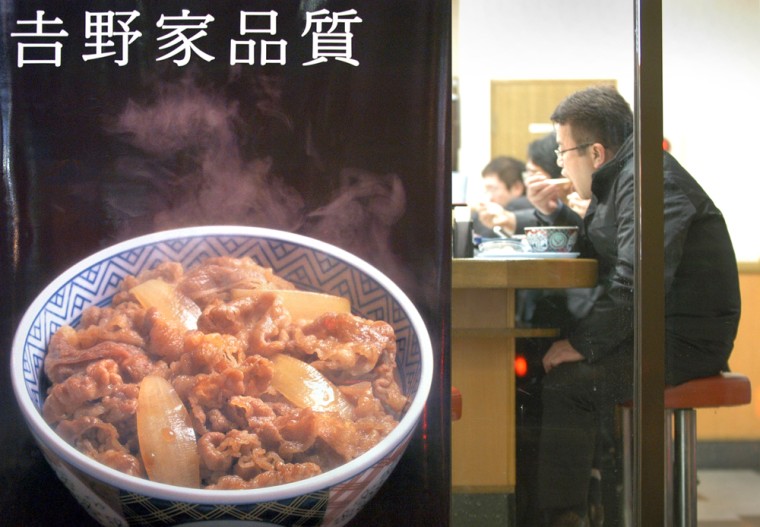The Yoshinoya fast-food chain says it will stop serving its trademark beef-and-onions rice dish unless Japanese authorities lift a ban on U.S. beef imports.
The Royal Host restaurant chain is considering whether it can increase the amount of beef it gets from Australia. McDonald’s Japan has taken out full-page newspaper ads reassuring consumers that its patties are made only with Australian beef.
News that a cow in Washington state tested positive last week for mad cow disease — the first U.S. case of the brain-wasting bovine ailment — has created a dilemma for restaurant chains in Japan, the world’s biggest customer for U.S. beef.
Japanese consumers have only recently regained their appetite for beef after a mad cow scare at home. So Japan’s restaurant groups are rushing to switch suppliers and offer alternatives.
But for low-cost chains like Yoshinoya, there’s no substitute for cheap U.S. beef.
With 980 restaurants nationwide, Yoshinoya relies on U.S. suppliers for 99 percent of the beef used in its “gyudon” beef bowl — which at about $2.50 is a staple for office workers and budget-conscious students.
Yoshinoya president Shuji Abe said the chain would run out of beef stocks in February. If the ban on U.S. beef imports continued, Yoshinoya won’t be able to keep serving its signature product, he said.
“I never thought our business would come to this,” Abe said.
Imports for everyday eating
Japanese beef is typically pricier than imports, and is often reserved for delicacies like sukiyaki — thin strips of marbled meat boiled with vegetables. At one Tokyo meat shop Tuesday, two pounds of homegrown sukiyaki-quality beef was selling for about $28 — around twice the price of comparable imported meat.
Japan imports about two-thirds of its beef, and around 47 percent, or more than 226,000 tons, came from the United States last year. The rest comes mostly from Australia and New Zealand, neither of which has had a reported case of mad cow disease.
It is unclear when Japan will reconsider the ban on U.S. beef. The government is reportedly holding out for tougher U.S. safeguards. When Japan discovered its first mad cow case two years ago, authorities started testing every cow intended for human consumption — something U.S. officials have called unnecessary.
The ban could cost U.S. beef producers. The United States sold $1.03 billion worth of beef, veal, prepared beef products and variety meats to Japan in 2002, accounting for about 32 percent of total exports.
So far, Japanese consumers have received mixed messages from retailers and restaurants about the U.S. case.
Supermarkets are split over whether to pull U.S. beef from their shelves. Some restaurants have put up signs saying their beef isn’t from the United States. McDonald’s Japan has taken out the newspaper advertisements. Others have insisted their beef is safe because it comes from U.S. states other than Washington.
Nakau Co., which serves gyudon at its 263 stores across Japan, and Mos Burger, a hamburger chain, said the cuts of U.S. beef they use are safe from infection.
Ground beef from labeled cuts like chuck or round, as well as beef steaks, roast, liver and tongue, are considered safe, experts say.
The Japanese government has announced plans to send officials to Australia to assess how much more beef that country can supply. The Japan Food Service Association last week advised restaurants to rethink their business strategies.
“Relying completely on foreign procurement is risky,” chairman Kiwamu Yokokawa said.
Costly options
A few restaurants have been looking into alternative suppliers on their own.
Royal Co., which runs 341 Royal Host restaurants in Japan, said 80 percent of its beef comes from Australia, with the rest from the United States.
“We have begun considering whether it’s possible to import more from Australia in case the ban on U.S. imports continues,” said spokesman Takahisa Jojima.
But Yoshinoya said other options would be too expensive.
“If our prices went up, it would drag down our image,” Abe said.
The Bush administration is taking major steps to boost confidence in the U.S. beef supply at home and abroad, where more than 30 countries have banned American beef products since mad cow disease first surfaced in Washington state a week ago.
The changes announced Tuesday include a ban on meat from cows that can’t walk or stand on their own and a promise to speed creation of a nationwide animal tracking system. Agriculture Secretary Ann Veneman said consumers shouldn’t see an increase in prices as a result.
A spokesman for the meatpacking industry, however, said beef prices could increase “pennies per pound.” The projected cost for the tracking system that would allow rapid response to a disease outbreak is more than $500 million for the first six years.
In Canada, meanwhile, food safety investigators established a tentative link between an Edmonton rendering plant and the infected Holstein, the Edmonton Journal reported Wednesday.
